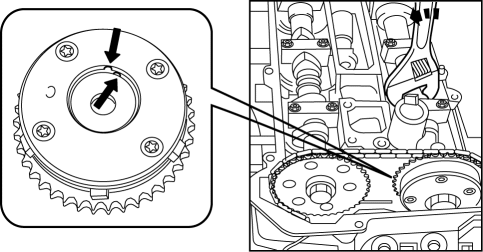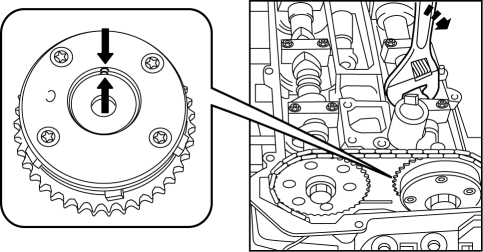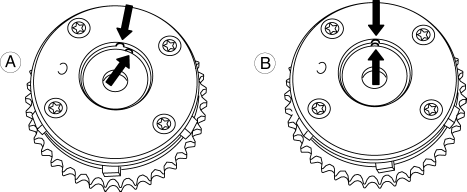Mazda 3 Service Manual: Variable Valve Timing Actuator Inspection [Mzr 2.0, Mzr 2.5]
CAUTION:
-
Variable valve timing actuator can not be disassembled because it is a precision unit.
1. Remove the battery cover..
2. Disconnect the negative battery cable..
3. Remove the plug hole plate..
4. Disconnect the wiring harness.
5. Remove the ignition coils..
6. Remove the spark plugs..
7. Remove the ventilation hose.
8. Remove the oil level gauge.
9. Remove the cylinder head cover..
10. Inspect the variable valve timing actuator for damage around the stopper pin cap (A), or a missing stopper pin cap (B), spring and stopper.

-
If no parts are damaged or missing, go to the next step.
-
If any parts are damaged or missing, replace the variable valve timing actuator..
CAUTION:
-
If any parts are damaged or missing, remove the front cover to inspect the timing and oil pump chains and all related components for damage as a result of lost parts. Replace components if necessary.
-
If the lost parts cannot be located in the timing chain area, it will be necessary to remove the oil pan to retrieve them.
11. Turn the crankshaft clockwise so that the notches on the variable valve timing actuator can be checked.

12. Turn the camshaft counterclockwise to align the notches on the variable valve timing actuator.

13. With the notches aligned, turn the camshaft clockwise 30 degrees.

14. Verify the notches again.

-
A: If the notches are not aligned, replace the variable valve timing actuator..
-
B: If the notches are aligned, there is no problem with the variable valve timing actuator.
NOTE:
-
In some rare cases, the timing chain tensioner ratchet lock may get stuck, which will require the removal of the engine front cover.
15. Install in the reverse order of removal.
 Variable Tumble Solenoid Valve Inspection [Mzr 2.0, Mzr 2.5]
Variable Tumble Solenoid Valve Inspection [Mzr 2.0, Mzr 2.5]
Airflow Inspection
1. Remove the battery cover..
2. Disconnect the negative battery cable..
3. Remove the variable tumble solenoid valve..
4. Inspect airflow between the ports under the followi ...
 Variable Valve Timing Actuator Inspection [Mzr 2.3 Disi Turbo]
Variable Valve Timing Actuator Inspection [Mzr 2.3 Disi Turbo]
CAUTION:
Variable valve timing actuator cannot be disassembled because it is a precision
unit.
1. Remove the battery cover..
2. Disconnect the negative battery cable..
3. Remove t ...
Other materials:
No.6 Bsm Indicator Light Flashes While Not Under Bsm Indicator Light Flashing
Conditions (No Combination Switch Operation (Turn Signal Switch)) [Blind Spot Monitoring
(Bsm)]
6
BSM indicator light flashes while not under BSM indicator light-flashing
conditions (no combination switch operation (turn signal switch)
Description
The BSM indicator light flashes despite not satisfying the BSM indicator
l ...
Front Seat Belt Removal/Installation [Two Step Deployment Control System]
WARNING:
Handling the front seat belt (pre-tensioner seat belt) improperly can accidentally
deploy the pre-tensioner seat belt, which may seriously injure you. Read the
air bag system service warnings and cautions before handling the front seat
belt..
WARNING:
Th ...
Vacuum Line Inspection
MZR 2.0, MZR 2.5, MZR 2.3 DISI Turbo
1. Remove the vacuum hose..
2. Verify that air can be blown from the power brake unit side of the vacuum
hose towards the intake manifold side, and that air cannot be blown in the opposite
direction.
If there is any malfunction of the inner che ...
